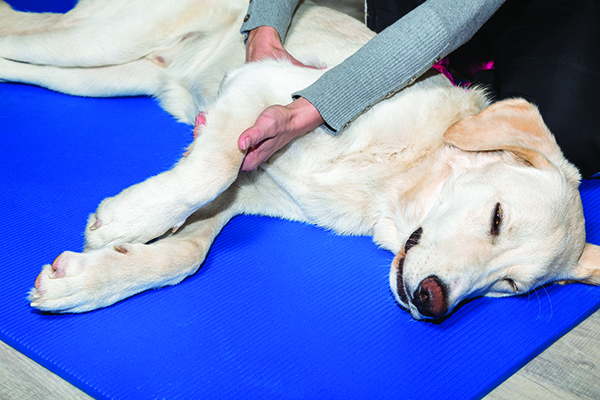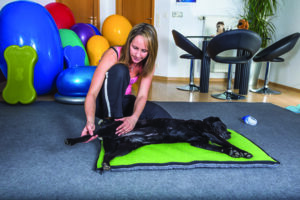
It’s been so long since we reviewed instructional canine massage media that our original headline said, “WDJ Reviews Videotapes That Teach Massage.” Remember videotapes?
The search for video demonstrations used to take time and effort, but today’s DVDs and streaming services make it easy to collect information about canine massage, master the basics, enhance your dog’s life, and even work toward canine massage therapist certification – without leaving home.
For dogs, as for humans, the benefits of massage include relaxation; the release of tension, pain, and muscle spasms; increased flexibility; enhanced immune function; improved athletic performance; faster recovery; and body alignment corrections that help prevent injuries.
Targeted techniques improve the health of elderly, infirm, and handicapped dogs; working livestock or hunting dogs; sports competitors; and family pets. Pre-activity massage prepares a dog for active exercise, while post-activity massage helps the dog recover from exertion.

At-home massage enhances the emotional bond between dogs and their caregivers, and frequent massages make it easy for owners to notice unusual lumps or other symptoms that should be checked by a veterinarian.
Some of the massage schools recommended in our 2002 article have grown, and new presenters have added innovations and variety. Here are updated descriptions of the instructional-product offerings we’ve reviewed:
* Jean-Pierre Hourdebaigt combined traditional and modern massage techniques for dogs and horses when he founded the Massage Awareness Method in 1995. Hourdebaigt offers downloadable video clips that demonstrate proper positioning, hand sensitivity (pressure, contact, and rhythm), basic massage movements, relaxation routines, stretching guidelines, hydrotherapy (heat, cold, and ice-cup techniques), methods that reduce edema and inflammation, trigger-point massage, stress-point massage, and other approaches.
Training tools include free online articles, instructional videos, DVDs, and consulting services. See animalawareness.com.
*Joanne Lang, executive director of the Lang Institute for Canine Massage, offers a 688-hour course that trains professional canine massage therapists by combining home study with a four-day hands-on practicum in which students practice specific techniques.
“Most people know very little about structural faults in animals,” Lang says, “or even that they exist. Understanding structure helps owners support weak areas and prevent cumulative injuries.”
Lang’s favorite success stories involve dogs who could not walk but who, thanks to massage, went on to lead active lives. “You don’t have to be an expert to improve your own dog’s health and life, for even gentle massage can make a big difference,” she says. See dogmassage.com.
* Mary Schreiber, who created Equissage in 1991, claims to have trained more than 20,000 animal massage therapists. The Equissage Equine and Canine Sports Massage training has been available as a home-study program since 2000. Though she originated her methods on horses, Schreiber adapted a sequence of massage strokes for canine use.Owners of canine athletes who sled, racd, and hunt, and enjoy other sports are her most enthusiastic students.
“I use the same basic sequence for dogs and horses,” she says, “but I added some new sports massage strokes for dogs. While this muscle therapy was designed for all dogs, it’s especially well suited to dogs whose muscles are overused and overworked.” See equissage.com.
* Patricia Whalen-Shaw became a licensed massage therapist for humans and in 1992 expanded to animals by holding clinics for horse, dog, and cat massage. In order to train animal massage therapists, she created Integrated Touch Therapy, which combines Swedish and sports massage with other techniques in a logical, progressive system.
“My method is designed to do no harm and cause no pain,” she says. “It’s soft and requires patience. That doesn’t mean it isn’t deep or that it isn’t effective. It just doesn’t overwhelm the animal. We never force muscles to do anything. Instead we stay within the animal’s comfort zone and wait for the tissues to soften and for the protective contracture, or tensing of muscles, to stop.” See integratedtouchtherapy.com
* Jonathan Rudinger, a licensed massage therapist for humans, began working with horses in 1982 and in 1997 became a canine massage therapist. During a TV program that featured Rudinger, the interviewer brought out an elderly Golden Retriever and announced, “Dogs get stiff necks, too. What can you do to help?” A minute later, the dog melted into Rudinger’s hands. “That was the turning point,” he says. “I knew I had skills and techniques that I could share with people to bring comfort to their animals.”
Rudinger went on to establish the PetMassage Training and Research Institute in Toledo, Ohio. In his videos, Rudinger demonstrates hand positions and conventional massage strokes. To these he adds thumb-walking on the face and along the spine and clasped hands, which gently lift the chest and abdomen. His head-to-tail massage includes the eyes, mouth, and gums.
In addition to training professional massage therapists, the Institute offers home-study books and DVDs, including “Pet Massage for the Family Dog” and “Pet Massage for Kids.” “If you work with your dog’s permission and follow instructions,” he says, “you can’t make a mistake.” See petmassage.com.
* Angelique Barbara, D.C., is a chiropractor for humans whose training includes a bachelor’s degree in veterinary science and a master’s in veterinary pathobiology. She offers online training in canine massage therapy certification as well as a home-study course for dog owners who want to learn the basics of pet massage.
Her online Canine Massage Course for Dog Owners examines the history of massage, foundation massage strokes, Swedish massage techniques, myofascial release, basic stretches, and related methods, including aromatherapy.
According to her website, “Dr. Barbara was one of the first practitioners to start utilizing kinesiology tape on animals and she was so impressed with the results that she decided to develop an entire seminar dedicated to the taping applications she developed. Her background in both the clinical and research animal health care world as well her experience as a human chiropractor give her a unique perspective on animal bodywork, which is evident in her courses.” See holisticanimalstudies.org.
* Christin Finn, DVM, is a veterinarian with credentials in chiropractic and osteopathic manipulation, veterinary acupuncture, and Traditional Chinese Medicine. She and her staff at the Canine Rehabilitation and Integrative Veterinary Center in Kingston, Washington, approach mobility and health issues by treating the whole animal, rather than single ailments, while correcting imbalances in the body’s movement and structure that create pain and illness. “Optimal health and happiness can be achieved when all systems are in balance,” she explains.
Dr. Finn produced a series of YouTube videos for dog lovers, showing how to breathe while massaging your dog, how to use passive range of motion techniques on younger and older dogs, and how to massage small dogs. See finndvm.com.
* Nick Scott and Jamie Roth founded the Ojai School of Canine Massage in 1999 in Ojai, California. Their home-study program combines Skype, audio, and video instruction with their 250-hour onsite certification program’s education in dog-gait and conformation assessment, professional documentation, dog nutrition, business, anatomy, physiology, remedial exercise and stretching for dogs, and First Aid.
Students also learn canine acupressure, myofascial release, Swedish massage, trigger point therapy, TTouch for dogs, sports massage, and energy work for dogs.
As the school’s website explains, “We are devoted to a holistic approach to healing. Our courses are designed to provide each student with a thorough and well-rounded education, while providing the most current information available in the dog massage field. We prepare our graduates to successfully enter the workforce as professional canine massage therapists.” See ojaischoolofmassage.com.
* The Canine Massage Therapy Center in the United Kingdom offers in-person and remote training for pet lovers, clinical canine massage practitioners, dog trainers, sporting dog handlers, and owners of performance/competition dogs. While its 2021 schedule is still being arranged, U.S. residents can study instructor Natalie Lenton’s “Essential Guide to Safe, Effective Canine Massage at Home (Canine Massage in 3 Easy Steps)” by ordering this 2011 DVD from amazon.com or other retailers.
The “three easy steps” are a dot-to-dot introduction to your dog’s skeleton and main muscle groups; a tutorial that demonstrates six massage techniques; and a step-by-step whole-body massage routine that addresses aching muscles and stiffness. See k9-massage.co.uk.
Streaming videos give us instant access to long and short demonstrations of every description. One of them features the well-known author, “It’s Me or the Dog” TV presenter and dog trainer Victoria Stilwell. In this video, Stilwell introduces Melanie Phillips, a certified dog trainer and dog massage specialist, who explains how to use massage to help your dog recover after an injury or to simply relax. See tinyurl.com/WDJ-massage-MelaniePhillips.
Narda Robinson, DVM, director of the Colorado State University Center for Comparative and Integrative Pain Medicine, demonstrates simple techniques you can do at home to help alleviate your dog’s pain and discomfort in a four-minute video that demonstrates compression (gentle limb squeezing), effleurage (long, soothing strokes), and petrissage (kneading or rolling motions). See tinyurl.com/WDJ-massage-NardaRobinson.
Marc Smith, DVM, a veterinarian from Nashville, Tennessee, explains in a 10-minute video how to alleviate a dog’s arthritis pain with simple at-home massage. Starting at the knee, Dr. Smith moves to the hip and back, demonstrating how to move and hold a leg or joint to break up adhesions that contribute to pain. He also describes how to respond if a dog is uncomfortable while being touched. See tinyurl.com/WDJ-massage-MarcSmith.
Jenny Youdan at K9 Elements Massage Therapy in England is certified in Swedish massage, sports or deep tissue massage, and myofascial release. In the video at the link below, Youdan gives an overview of clinical canine massage, explaining the basics of canine anatomy and massage therapy. She describes what can go wrong, why dogs may feel stiff after exercise, and how massage can help with muscle strains and other problems. See tinyurl.com/WDJ-massage-JennyYoudan.
Jen Carver, a veterinary technician, certified canine rehabilitation practitioner, and canine massage therapist in Ontario, Canada, demonstrates in a 14-minute video how to perform a relaxation massage. See tinyurl.com/WDJ-massage-JenCarver.
Leilani Alvarez, DVM, is head of the Animal Medical Center’s Integrative and Rehabilitative Medicine Service in New York City. This 50-minute video shows Dr. Alvarez demonstrating canine massage on a Golden Retriever patient, followed by corrective exercises, during which she emphasizes the importance of owner participation in any pet-rehabilitation program. See tinyurl.com/WDJ-massage-LeilaniAlvarez.
There are many more canine massage hints, tips, and how-to demonstrations at YouTube and other online resources, yours free for downloading. Between short streaming videos and more detailed recordings on DVD or at massage-related websites, you’re sure to find guidelines that fit your schedule and experience level so that you and your dog can benefit from and enjoy massage’s healing touch. And who knows? You may decide to pursue canine massage as a vocation!





Great timing! In September, I am headed to attend a school not listed in this article, the Rocky Mountain School of Animal Accupressure and Massage in Colorado. I am excited become a Canine Massage Therapist, my focus will be on agility dogs. My retired agility dog got so much benefit from a body worker that is a RMSAAM alumnus. Every body loves a massage!🐾
Thank you! You provide such an abundance of useful info!